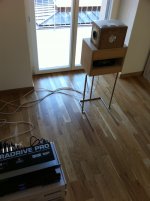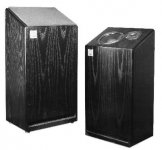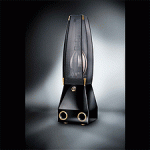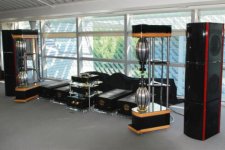Graaf, did you read it?
Dan
the NASA paper? I skipped through it using Ctrl+F "reflections", "apparent" etc.
here is what I found interesting, not much, so to speak...
at p. 91:
The temporal resolution for integration of speech or music is around 20 msec, which “irons out” most of the spectral irregularities of a room caused by reflections (Schroeder, 1973). Nevertheless, the perceived timbre and attack qualities of sound sources, especially of musical instrument sounds, can be changed substantially by early reflections without affecting intelligibility. One hears a cello, for example, not only from vibrations emitted from the instrument itself, but also from early reflections from the floor and walls. Most professional musicians are very aware of the manner in which a stage or other floor surface interacts with their instruments. Besides altering the timbre of the instrument, early reflections can also modify the rise time of the attack portion of the amplitude envelope. An extreme example of this is the lack of “bite” a pizzicato (finger pluck) note has on a stringed instrument in a highly reverberant room.
read: as far as sound quality is concerned it's not recommended to play a guitar in a bathroom
at p. 94:
Some have tried to simplify the situation by limiting the number of perceptual criteria. Borish (1986) stated that “the only subjective effect of delayed sounds when laterally displaced is spatial impression,” and that “there is an infinite number of ways of generating the same spatial impression by simultaneously varying the azimuth and amplitude of the secondary sounds. Two sound fields may differ objectively, yet have the same subjective effect.” Another example is the concept of clarity or c80. This is quantified by dividing the energy of the first 80 msec (the early reflections)
by the reverb after this point (the late reflections). Griesinger (1993) points out that its perceptual meaning can be ambiguous, implying intelligibility to some people and apparent source width as it relates to the “ease of localization” of a sound source to others. It is evident that a number of interrelated variables are at work that are difficult to pin down. For instance, apparent source width can be affected by spatial impression and clarity, which are in turn related to distance and envelopment by a sound source, all of which are influenced by reverberation.
read: there are some concepts, it's difficult to pin down what really matters
and at last this one:
at p.40:
One independent variable that has been manipulated in several localization studies is the rise time of the amplitude envelope of a stimulus. Generally, after a certain threshold, the slower the rise time of the envelope, the worse localization becomes—especially in reverberant environments (Hartmann,1983). This is because the inhibitory mechanism of the precedence effect diminishes under these circumstances and because the ITD envelope cue can no longer be analyzed within the region of a perceptual temporal integration “window.” Within certain reverberant contexts, transient information can also be smeared over time at the point where the sound reaches the listener. This sensitivity of hearing to ITD transient information applies particularly to the spatial perception of moving sources; a sound trajectory defined by a source that has rapidly articulated transients is easier to localize than one with a slow amplitude envelope rise time.
and at p. 90:
In a localization study using the variable reverberation acoustics of an adjustable room (Hartmann, 1983), it was found that lateral early reflections (reflections from the side) degraded localization accuracy. The expanded apparent source width that can occur with reverberation could also make the estimation of a particular location more difficult, since there is a larger area on which to consistently place a center of gravity for azimuth (and elevation) judgments. Figure 3.17 shows the difference in localization accuracy for HRTF-processed speech between anechoic stimuli and stimuli processed with synthetic spatialized reverberation (Begault, 1992a). For most target azimuths, localization is worse with the addition of reverberation. This demonstrates how the precedence effect only partially suppresses the effects of reflected energy.
read: something was found by a certain Hartmann in 1983 but we do not know the exact methodology of His tests therefore it's difficult to tell what exactly was found
overall - what an impressive research!
unbiased listeners have no difficulty recognizing accurate sound reproduction, even with hearing damage or with hearing aids
Graaf, not all sounds are enveloping and spacious.
Dan
Quite correct Dan but total absence of spaciousness isn't desirable either. A solution that allows for controlled spaciousness would be nice to have. Putting a ceiling-firing speaker with limited SPL somewhere in the room isn't the solution. It's like spraying paint with a garden hose into a fully furnished room when all you want to do is change the color of the walls.
Last edited:
Agrees with Sound Reproduction.
Dan
I haven't got time now to counter with long quotations from Toole and I cannot repost the quotations I once posted in another thread as they were removed by local police unfortunately
OTOH no point posting long when all I can reasonably expect to get in reply are 3-4 words with an
therefore I think it's perfectly sufficient just to quote briefly another classic:
the point where I differ from Floyd.
(...)
Floyd implies that ALL lateral reflections are good, but as you correctly point out, he cannot really make this statement for very early reflections based on his data.
take notice that Dr Geddes makes His reservation only with regards to those highly specific VERY early reflection, as from tweeter face plate or in a horn for example
Putting a ceiling-firing speaker with limited SPL somewhere in the room isn't the solution.
how can You know anything about it? Do You remember Stereosphere™? so, what is your educated theorising really worth?
how about an Omnisphere™?
You may want to ask Dr Geddes about that Graaf. He highly weights imaging in his designs and they have a narrow pattern as I'm sure you know.
Markus, I completely agree and a great analogy.
oh yeah Markus is great ...uhm... analogist so to speak
You may want to ask him about amazing Stereosphere™ (picture below)
Attachments
another short polydirectional flooder:
Direct Acoustics
it is interesting to see how an American engineer who worked for AR, KLH, EPI and so on... finally arrived, quite independently, at something very similar to a Swede engineer Carlsson
direct_acoustics
Direct Acoustics
it is interesting to see how an American engineer who worked for AR, KLH, EPI and so on... finally arrived, quite independently, at something very similar to a Swede engineer Carlsson
direct_acoustics
Let's start with the good points about these speakers.
...
Imaging and Soundstaging
This is an area that many of you will disagree with me, but I think the imaging characteristics of these speakers are not just acceptable, but in their own way, superb. As one would expect from a speaker placed just a few inches from the wall, there is not a lot of image depth. Nor, for that matter, is there the pinpoint, specific location of everything that you get out of small mini monitors (which I think generally make too many instruments sound unnaturally small). However, what you do get, and what I think is very valid, is a massively huge stage, both laterally and vertically, as if the entire wall behind the speakers was now a window (or maybe a movie screen) that has become the stage. Enhancing that effect is the fact that, except for some added sound effect or from very poor recordings, no sounds ever appear to come directly from the speakers. The Silent Speakers do the disappearing act better than pretty much any speaker I have ever reviewed (please note that this is true in my system using the Audio Space Line-2 preamp, but not quite so much when using my PS Audio 4H passive preamp, where the stage is a little smaller).
One example of this is the beginning of the track Wish You Were Here, from Pink Floyd's album of the same name. At the beginning, the guitar is played through (or least made to sound like) a table radio, coming from just one speaker. With the Silent Speakers, this sounds like a real table radio sitting on top of the speaker, as if it was a small table. Then, when the lead guitar starts up (a superb recording of a guitar) it sounds remarkably natural both in tone and in size, floating in space is if the guitarist was standing right there between the speakers.
Last comment image-wise, is that there is no real sweet spot, or maybe it's that the sweet spot is about ten feet wide. I can sit anywhere on the coach in my listening room and the sound doesn't really change. It is a little brighter when I stand up, but that's about it. These are great speakers if you actually move around or do other stuff with music playing!
I don't normally discuss imaging this much in my reviews, but I have been continually taken in by the overall imaging of this system.
...
what do I hear as limitations in the Silent Speakers? Here they are.
Detail
These speakers slightly obscure detail. They don't make a bowl of mush out of the music the way mid-fi speakers at the big box stores do, but they don't have that extreme clarity that you get from other competitive speakers. The leading edges of transients are somewhat soft. This is most noticeable on one particular instrument, the snare drum. Though other parts of the drum kit sound fine (and cymbals in fact, sound exceptional), the snare always sounds a little on the soft side. It's not that they sound recessed or distant, just a little indistinct.
High Frequencies
Considering that you are listening to the tweeters somewhere between thirty and sixty degrees off axis, it is not too surprising that the higher frequencies are a little rolled off. I suppose if you listen to a lot of new age music or audiophile favorites with chimes, bells and other such tests of high frequencies, this may bother you more than it bothers me. The top end is certainly okay, not rolled off like the paper tweeters from the 60s and early 70s, but not as extended or airy as you can get out of some other, even similarly priced current designs. You certainly don't want a heavily damped or padded wall behind these speakers, as they are designed to have the sound reflect off the wall behind them. The higher frequencies do actually remind me of the top end of the old EPI and Burhoe speakers, which were considered quite good in that regard at the time.
The somewhat rolled off high frequencies and slightly diminished detail do make the speaker sound a little less transparent than some other speakers I've reviewed. This is hard to quantify, as just as describing "transparency" to someone is often very difficult.
...
Soundstaging and Imaging
Wait a second; didn't I list this under the speaker's strengths? Yes, in fact I did. But this is to acknowledge that if you do insist on that small, pinpoint (and I think unrealistic) super specific imaging that you get from many "high-end" speakers you might not appreciate the large, expansive soundstage that the Silent Speakers produce. Again, just a matter of taste and expectations, not really right or wrong, and I do prefer the imaging of these speakers.
Who made them?
Winslow Burhoe, one of the pre-emminent North American speaker designers of all time.
Good to see him still chugging along.
dave
Those look like humidifiers with the grills on.
Who made them?
Here is another odd looking set of omni speakers - only $263K. I think that is for the pair - but I'm not sure. Dealers tend to lock their doors and lower the blinds when they see me driving by the store looking for a parking space.
Hmmm..... when I try to upload it says that my PNG image has the wrong file extension. I'm loading a JPEG - and it's 158K so small enough to fit - I never had this problem before. It's a photo of the MBL 101....
Ok - uploaded a GIF file -
Attachments
Last edited:
Ta derwhalfisch - now all I need to do is win the lotto!! Seeing as how I don't gamble and thus do not purchase lottery tickets - well I guess I need to come up with another plan. Oh - I know a way! Former USA VP Al Gore lives here in Nashville - I'll just pop in and sell him some line about how it will help to combat global warming if he will just chip in a few hundred grand to help out my cause!!!
OTOH - U2 is playing in town tonight - perhaps I can hit up Bono after the gig???
Nah - asking for a hand out just isn't my way of things. Guess I'll just have to DIY a pair - for like 2 grand.
OTOH - U2 is playing in town tonight - perhaps I can hit up Bono after the gig???
Nah - asking for a hand out just isn't my way of things. Guess I'll just have to DIY a pair - for like 2 grand.
Hey Thomas, it's only 70k in Singapore ! Maybe the price tag you give is for the very big one that has everything in double.
Ahhhh - my mistake! Actually we are both correct. The MBL 101 is merely $70K. The MBL 101 extreme is the one that is $263K. Speakers - MBL of America
Attachments
Originally Posted by c2cthomas :
Guess I'll just have to DIY a pair
Why not, with some super skills like here !!!
- Home
- Loudspeakers
- Multi-Way
- Why are OMNI speakers not more popular?



